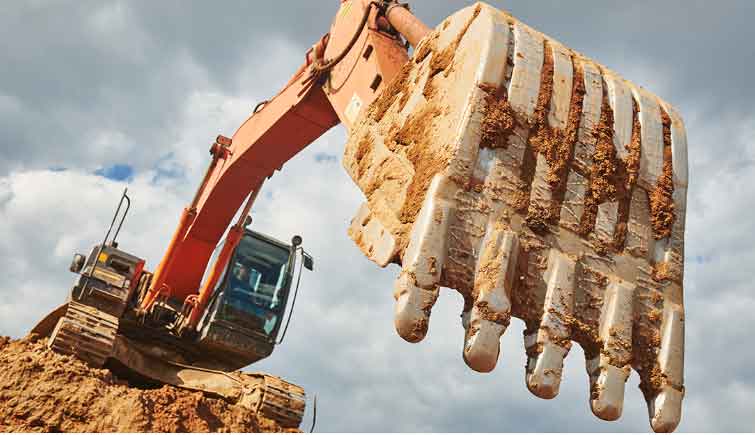Introduction
Wear-resistant bucket teeth are critical components in mining and construction machinery, operating under extreme abrasive conditions. Traditional materials such as high-manganese steel, carbon steel, low-alloy steel, and surface-hardened variants often fail to balance wear resistance with toughness, leading to premature failure. This study introduces a bimetal composite casting technique that synergizes the high wear resistance of chromium-rich alloys with the toughness and cost-effectiveness of structural steel, significantly extending service life.

Material Selection and Experimental Setup
Base Material and Wear-Resistant Alloy
- Base material: ZG35 steel (composition: 0.35% C, 0.6% Mn, 0.3% Si, balance Fe).
- Wear-resistant alloy: High-chromium cast iron (designation: KmCr15Mo2-DT; composition: 15% Cr, 2% Mo, 3% C, balance Fe).
Equipment
- 150 kg medium-frequency induction furnace for melting.
- Portable pyrometer for temperature monitoring.
Bimetal Composite Casting Process
The process involves embedding pre-treated KmCr15Mo2-DT alloy blocks into a ZG35 steel mold (Figure 1, omitted). Molten ZG35 steel (1600–1650°C) is poured over the alloy blocks, creating a metallurgical bond via thermal diffusion. Key parameters influencing bond quality include:
| Parameter | Symbol | Range/Levels |
|---|---|---|
| Pouring temperature | Tp | 1550–1650°C |
| Alloy block thickness | t | 3–8 mm |
| Preheating temperature | Th | 25–400°C |
Critical Formula:
The interfacial bond strength (σb) depends on thermal compatibility:σb∝Th⋅αalloy⋅EalloyTp⋅αsteel⋅Esteel
where α = thermal expansion coefficient, E = Young’s modulus.
Orthogonal Experiment Design and Results
A 33 factorial experiment (Table 1) evaluated the effects of pouring temperature (Tp), alloy thickness (t), and preheating (Th) on bond quality.
Table 1: Orthogonal Experiment Design
| Level | Tp (°C) | t (mm) | Th (°C) |
|---|---|---|---|
| 1 | 1550 | 3 | 25 |
| 2 | 1600 | 5 | 240 |
| 3 | 1650 | 8 | 400 |
Table 2: Key Results
| Sample | Tp | t | Th | Bond Quality |
|---|---|---|---|---|
| 1 | 1550 | 3 | 25 | Cracks in alloy |
| 2 | 1550 | 5 | 240 | Optimal bond |
| 3 | 1550 | 8 | 400 | Partial unbonded regions |
| 4 | 1600 | 3 | 240 | Optimal bond |
| 5 | 1600 | 5 | 400 | Optimal bond |
| 6 | 1600 | 8 | 25 | Severe unbonding |
| 7 | 1650 | 3 | 400 | Best bond |
| 8 | 1650 | 5 | 240 | Partial cracks |
| 9 | 1650 | 8 | 25 | 33% unbonded |
Key Findings:
- Preheating temperature (Th): Increasing Th reduces thermal shock, minimizing alloy cracking. A threshold of Th≥240°C is critical.
- Pouring temperature (Tp): Higher Tp improves interfacial diffusion but risks alloy melting (Tp>1650°C). Optimal range: 1600–1650°C.
- Alloy thickness (t): Thinner blocks (t≤5 mm) enhance heat transfer, ensuring complete metallurgical bonding.
Field Performance Evaluation
Sample #5 (optimized parameters: Tp=1600°C, t=5 mm, Th=400°C) underwent field testing in a ZL80 excavator at Shuangcheng Quarry. Results after 53 days:
Table 3: Comparative Wear Performance
| Material | Cost (USD) | Wear Loss (g) | Failure Mode |
|---|---|---|---|
| High-manganese steel | 12 | 2412 | Abrasion |
| ZG45 steel | 10 | 2883 | Abrasion |
| ZG40CrMnSi steel | 14 | 336 | Fracture |
| T05 hardfaced steel | 18 | 807 | Abrasion |
| Bimetal composite (this study) | 13 | 463 | Uniform abrasion |
Performance Highlights:
- The bimetal wear-resistant bucket teeth exhibited 5×, 6×, and 2× longer lifespan than high-manganese steel, ZG45, and T05-hardfaced variants, respectively.
- No fractures occurred, confirming superior toughness.
Process Optimization Guidelines
To achieve defect-free bimetal wear-resistant bucket teeth:
- Pouring temperature: 1600°C≤Tp≤1650°C.
- Preheating temperature: Th≥240°C.
- Alloy block thickness: t≤5 mm.
- Flux application: 0.3–0.5 g/cm² to remove oxides and enhance wettability.
Economic and Industrial Impact
Replacing conventional bucket teeth with bimetal composites reduces downtime and material costs. For a mid-sized quarry using 200 bucket teeth annually:Annual Savings=(2412−463)g/tooth×200teeth×Cost per gram=$58,000
Conclusion
The bimetal composite casting process synergizes high wear resistance (KmCr15Mo2-DT) and toughness (ZG35 steel), delivering bucket teeth with unparalleled durability. Optimized parameters (Tp=1600–1650°C, Th≥240°C, t≤5 mm) ensure robust metallurgical bonding, validated by field performance. This innovation addresses a critical industry need for cost-effective, long-lasting wear-resistant bucket teeth.
